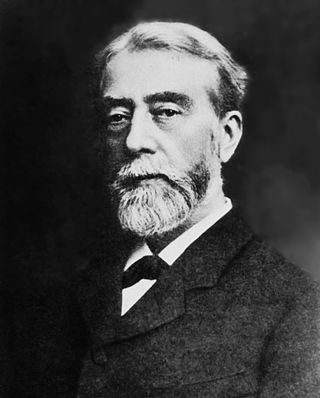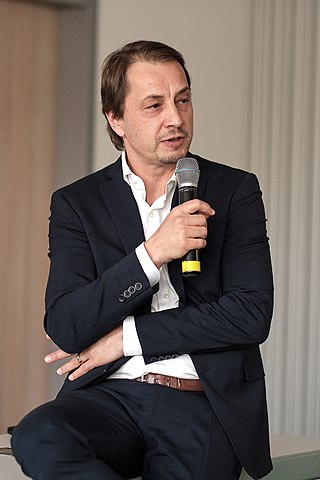Related Research Articles

Ophthalmology is a clinical and surgical specialty within medicine that deals with the diagnosis and treatment of eye disorders. A former term is oculism.

Charles David Kelman was an American ophthalmologist, surgeon, inventor, jazz musician, entertainer, and Broadway producer. Known as the father of phacoemulsification, he developed many of the medical devices, instruments, implant lenses and techniques used in cataract surgery. In the early 1960s, he began the use of cryosurgery to remove cataracts and repair retinal detachments. Cryosurgery for cataracts remained in heavy use until 1978, when phacoemulsification, a procedure Kelman also developed in 1967, became the modern standard treatment. Kelman was given the National Medal of Technology by President George H. W. Bush and recognized as the Ophthalmologist of the Century by the International Congress of Cataract and Refractive Surgery in Montreal, Canada. He was also inducted into the National Inventors Hall of Fame in Akron, Ohio, and received the 2004 Lasker Award.
Sir Nicholas Harold Lloyd Ridley was an English ophthalmologist who invented the intraocular lens and pioneered intraocular lens surgery for cataract patients.
Roberto Zaldivar is a Argentian doctor of ophthalmology and a refractive surgeon. He is credited with several breakthroughs in the use of laser to correct visual impairments. Zaldivar is credited for a technique called biotics, a term he introduced.

New York Eye and Ear Infirmary of Mount Sinai (NYEE) is located at East 14th Street and Second Avenue in lower Manhattan, New York City. Founded on August 14, 1820, NYEE is America's first specialty hospital and one of the most prominent in the fields of ophthalmology and otolaryngology in the world, providing primary inpatient and outpatient care in those specialties. Previously affiliated with New York Medical College, as of 2013 it is affiliated with the Icahn School of Medicine at Mount Sinai as a part of the membership in the Mount Sinai Health System.

Jacob Hermann Knapp, also known as Hermann Knapp, was a German-American ophthalmologist and otolaryngologist.

North Korea has a life expectancy of 74 years as of 2022. While North Korea is classified as a low-income country, the structure of North Korea's causes of death (2013) is unlike that of other low-income countries. Rather, causes of death are closer to the worldwide averages, with non-communicable diseases – such as cardiovascular disease – accounting for two-thirds of the total deaths.

Eric John Arnott, MA, FRCS, FRCOphth was a British ophthalmologist and surgeon who specialized in cataracts, a condition which in many parts of the world still remains the principal cause of blindness. He is known for inventing new surgical techniques for treatment of various ophthalmological disorders, and received professional awards for his contributions.
David J. Apple was an ophthalmic pathologist who conducted research on the pathology of intraocular lens complications as well as ophthalmic surgery in general. He was a medical historian and biographer of Sir Harold Ridley, the inventor of the intraocular lens (IOL).
He often stated that Harold Ridley changed the world. What we can say about David Apple is that he vastly improved the world that Harold Ridley changed
Raymond Mark Stein, MD, FRCSC, DABO, is a Canadian ophthalmologist. He practices refractive and cataract surgery. He is the medical director of the Bochner Eye Institute in Toronto, Ontario and Chief of Ophthalmology at the Scarborough General Hospital.
Sheraz Daya is a British ophthalmologist. Daya founded the Centre for Sight in 1996, and works in stem-cell research and sight restoration and correction surgery.
Gerd Geerling is a German consultant ophthalmic surgeon, Professor of Ophthalmology and since 2011 head of the Universitäts-Augenklinik Düsseldorf of the University of Düsseldorf, Germany.
Noshir Minoo Shroff is an Indian ophthalmologist notable for pioneering intraocular lens implantation surgery in India. He was awarded the Padma Bhushan in 2010 by the Indian government for his services to medicine.
Dr Amar Agarwal M.S., FRCS, F.R.C.Ophth is an Indian ophthalmologist and chairman and managing director of Dr. Agarwal's Eye Hospital and Eye Research Centre in India, which includes 190 + eye hospitals. He is the recipient of the Best Doctor award of the State government from then Chief Minister of Tamil Nadu J Jayalalithaa on 15 August 2014. He is also the past President of the International Society of Refractive Surgery (ISRS) and Secretary General of the Intraocular Implant and Refractive Society of India (IIRSI).
Keiki R. Mehta, an Indian ophthalmologist, medical researcher and writer, is considered by many as the father of Phacoemulsification in India. He is the Chief Surgical and Medical Director at Mehta International Eye Institute, a Mumbai-based specialty eye hospital founded by him. He is known to be the first surgeon to perform a Radial keratotomy in India and is credited with the development of the first soft eye implant in the world, and the Keiki Mehta BP Valve Glaucoma Shunt, a medical implant used in the treatment of neovascular‚ congenital and uveitic glaucoma. He is a recipient of several honours including the Grand Honors Award of the National Eye Research Foundation, Chicago and the Triple Ribbon Award of the American Society for Cataract and Refractive Surgery. The Government of India awarded him the fourth highest civilian honour of the Padma Shri, in 2008, for his contributions to Medicine.
Burkhard Dick is a German ophthalmologist who has specialized in refractive and cataract surgery. With his many contributions to the scientific literature on this topic, he is considered one of the pioneers of employing the femtosecond laser in cataract surgery. In the "Power List 2024" by the publication The Ophthalmologist, Burkhard Dick was listed among the world's most 100 most influential ophthalmologists.
The Heidelberg University Eye Hospital is one of twelve hospitals or clinics that make up the Heidelberg University Hospital. It is one of the most renowned and oldest Eye Hospitals in the Federal Republic of Germany with a lineage of ophthalmic surgeons of international standing. Located in the Kopfklinik on the Im Neuenheimerfeld Campus of the University of Heidelberg, it was prior to that in the city's Bergheim district. 2018 represents 150 years since the appointment of the first professorial chair in ophthalmology and the first building of the University Hospital Eye Clinic. One of the most famous alumni of the Heidelberg Eye Hospital was Dr José Rizal, (1861–1896), the Filipino martyr and national hero.

The Singapore National Eye Centre (SNEC) is a national eye specialty centre in Singapore.

Peter Szurman is a German ophthalmologist, scientist, and professor of ophthalmology in Sulzbach/Saar.
The German Society of Cataract and Refractive Surgery is the professional medical association of eye surgeons from Germany, Austria and Switzerland who specialize in treating cataract and refractive errors. Its office is based in Düsseldorf, Germany. The society, a nonprofit organization under German law, was founded in 1986 when implanting intraocular lenses (IOL) became standard in cataract surgery. The DGII holds an annual scientific meeting which besides cataract and refractive surgery also covers cornea diseases, glaucoma and retina. The society is closely associated with the European Society of Cataract and Refractive Surgery (ESCRS). In the context of this cooperation, the DGII is involved in the publication of one of the leading peer-reviewed journals in the field of eye surgery, the Journal of Cataract and Refractive Surgery (JCRS).
References
- ↑ Webb, Jennifer A. "Dr. Apple's lab endures in Heidelberg". Ophthalmology Times. Retrieved 26 August 2017.
- ↑ "Albert Schweitzer". David J Apple Laboratory. Retrieved 26 August 2017.
- ↑ Auffarth, Gerd (November 1989). "Meine Aufenthalte in Lambaréné 1988". Rundbrief für Alle Freunde von Albert Schweitzer. 68: 14 to 20. ISSN 0930-0937.
- 1 2 3 4 "Prof. Dr. med. Gerd U. Auffarth (MD, FEBO)". UniversitätsKlinikum Heidelberg. Retrieved 26 August 2017.
- ↑ "Ophthalmology Behind the Iron Curtain: Cataract Surgery in North Korea". ASCRS/ASOA 2012 - Virtual Films. Retrieved 26 August 2017.
- ↑ "Vorstand : DGII". DGII. Retrieved 26 August 2017.
- ↑ "Powerlist 2018". theophthalmologist.com. texerepublishing.com. Retrieved 6 April 2018.
- ↑ Rübsam-Brodkorb, Doris. "Chef der Universitäts-Augenklinik Heidelberg auf Platz zwei der weltweit wichtigsten Persönlichkeiten in der Augenheilkunde". www.klinikum.uni-heidelberg.de. Retrieved 3 May 2018.